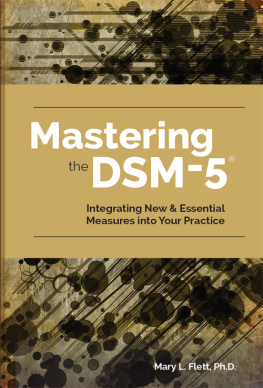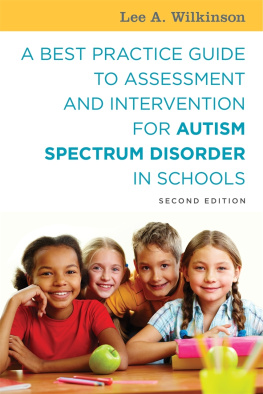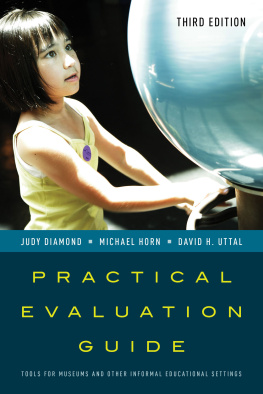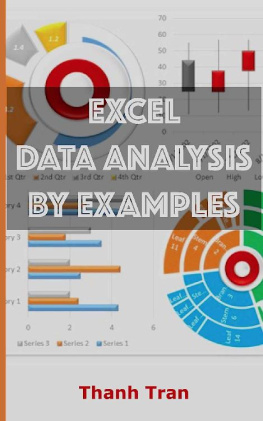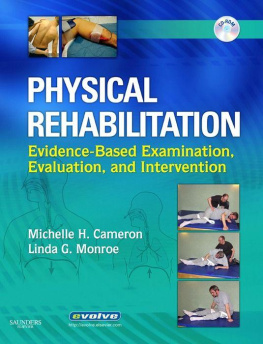Mastering
the DSM-5
Integrating New & Essential
Measures into Your Practice
By Mary L. Flett, Ph.D.
This is the only work Ive seen that addresses the complexity of Section Three in the DSM 5 with clarity, details and examples for its application. Dr. Flett has given us a valuable adjunct to the DSM which will enhance diagnostics and clarify levels of distress and disability. This book should be considered a must in understanding the DSM 5.
-Jack Klott, MSSA , LISW , CSW & national DSM-5 speaker & expert
Copyright 2014 by Mary L. Flett, Ph.D.
Published by
PESI Publishing & Media PESI, Inc
3839 White Ave
Eau Claire, WI 54703
Printed in the United States of America
ISBN: 978-1-937661-41-0
All rights reserved.
Dedication
To my husband, for seeing in me the things I could not see for myself; to my teachers, for helping me develop the skills and discipline to think and write; and to my clients, for being willing to open up and share.
Table of Contents
About the Author
Mary L. Flett, Ph.D., is a respected national speaker on the DSM-5 and how it is revolutionizing diagnosis and treatment. She is a licensed psychologist who focuses her practice on aging issues and behavioral rehabilitation, partnering with medical professionals, integrative medicine practitioners, and complimentary healing providers. Dr. Flett has worked in private practice, community-based agencies, and has provided services in both state and county government behavioral health systems. In addition to her clinical work across the developmental spectrum, Dr. Flett has conducted evaluation and outcomes analyses and quality improvement studies for county and state government. She has also taught at both the undergraduate and graduate levels.
Preface
This book will give you step-by-step instructions on how you can integrate the measures and evaluation tools contained in the DSM-5 and use them to inform your work with your clients and with others who interact with your clients.
A word about terms in this book: As a psychologist, I frequently switch between calling the individuals I work with clients, consumers, or patients. The change-up comes from having been in the field for over 20 years and also from the differences in nomenclature between professions.
I appreciate consistency as much as being politically correct. Use of language that is sensitive to the impact it has on those reading and listening and participating is something I have spent time considering in writing this book. I have intentionally chosen to use the word client throughout. It makes for consistent reading and understanding. I do not want you, the reader, to be distracted from what I am trying to say, nor do I want you thinking that I am adopting language reflective of pejorative applications of our work.
Introduction
W HY U SE A SSESSMENT M EASURES IN M ENTAL H EALTH ?
Although this seems an obvious question with an obvious answer, it is useful to clarify at the start what benefits there are to using assessment measures that have met standards of evidence-based practice. Just as you would not use a ruler to determine how much a person weighs, the use of the appropriate and accurate measurement makes a difference both in how information is gathered and the meaning that can be made of the results for individuals with mental disorders.
I believe it is useful to use assessment measures to see if what I am doing is making a difference in my clients life. I also believe that it is useful to my client to see that I am monitoring our work and that progress is being made. Finally, I believe it is useful to share results with my clients so that they see how our working together is making a difference in their lives.
Assessments are frequently used to gather information for other purposes such as program evaluation and/or justifying or confirming benefit for grants. It is important in situations like this that the findings be made useful to all stakeholdersstaff, consumers, students, grant funders, etc. Without useful information, the administration of the measures can frequently be seen as a barrier or worse, a form of punishment that gets in the way of the therapeutic connection needed to create opportunities for change.
Having a positive, open attitude toward implementation of these measures is key in assuring that the benefits and value of the effort needed are sustained. Development of this attitude comes from exposure to the measures themselves, allowing for adequate training and understanding of how the measures can be used, and a thorough immersion in the scoring and interpretation of the results. Only at that point can the clinician begin to make meaning of the results in collaboration with the client.
Too often there is a gap between the need for data and how it is gathered. What seems to be missing is letting all the participants in on the Why? I have worked in a variety of settings where these aspirational values have not been achieved, resulting in resentment by clinicians, frustration by clients, and a waste of valuable time on the part of administrators and supervisors across specialties.
My experience has opened my eyes to the necessity of finding ways for clinicians to apply the information gathered using these measures both to impact the work with clients, and to shift the focus from getting the information to using the results. Depending on your setting (private practice, clinic, government, military), how you incorporate these tools will provide you with opportunities to learn more about how you practice, how your clients/respond to your approach, and how the systems you interact with can be improved. And this does not need to be burdensome, onerous, or a barrier to your doing your work the way you do it.
The fact that you are picking up this book suggests that you already have some ideas about the use of behavioral measurements. My goal in the remainder of this book is to share some of my ideas, having worked with and struggled to find practical uses for measures such as these, and to show you ways to integrate these tools into your practice. Whether you are an experienced clinician, researcher, program evaluator, or a graduate student, this book will clearly explain the measures, provide examples of how they can be used in a variety of practice settings, and inspire you to use them in improving your work.
H OW TO U SE THIS B OOK
This book is designed so that you can go to a specific chapter discussing one measure, get an overview of its development and how it can be used, and how to score, interpret, and apply that information to your practice. You can also start at the beginning and just move through each chapter.
You can use this book as a resource for forms and interpretive guidelines when administering the measures. Each chapter includes information on how to explore the results and make meaning with your clients and with other treatment professionals.
Finally, you can use this book as an adjunct to the DSM-5.
P LANNING FOR C HANGE
How do you get started? This takes a bit of planning and thought, but it follows a well-established format. This is known as continuous quality improvement and has four basic phases: plan, do, study, act. The steps are identified below. Resources for implementing change in various settings are discussed in the following chapters.
Next page
